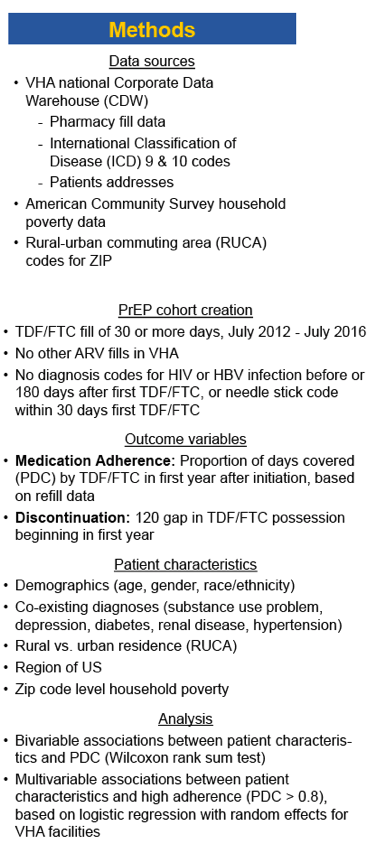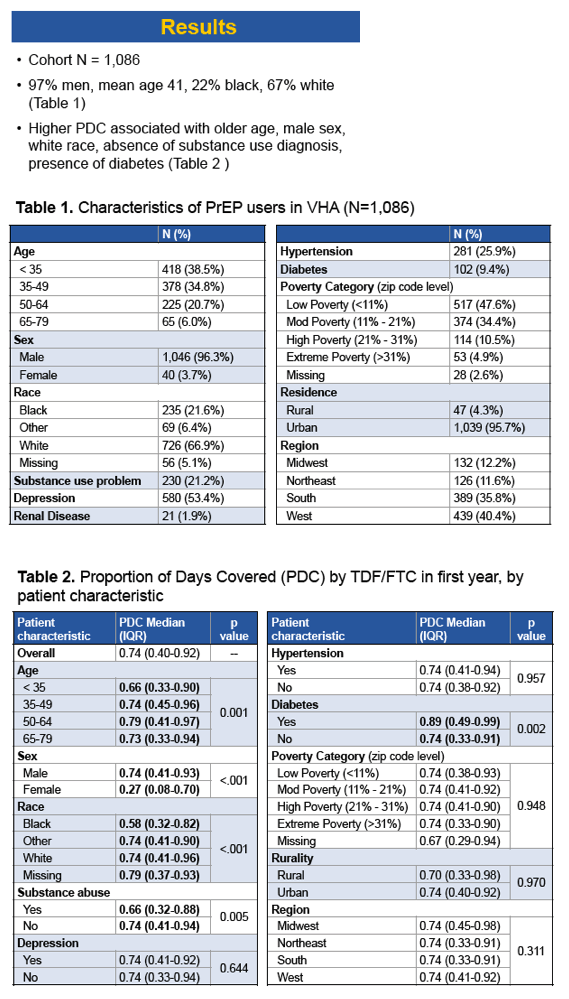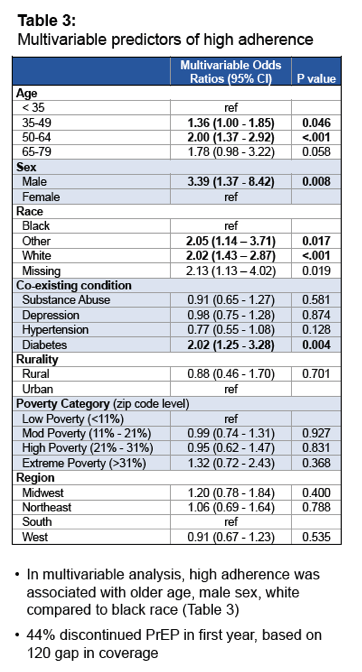 |
 |
 |
| |
Age, Gender, Race Predict Long-Term PrEP Adherence in Large Veterans Group
|
| |
| |
IDWeek2017/IDSA, October 4-8, 2017, San Diego
Mark Mascolini
Analysis of 1086 US veterans starting preexposure prophylaxis (PrEP) determined that older age, male sex, white race, and diabetes independently predicted high adherence [1]. Almost half of the cohort, 44%, stopped PrEP within 1 year.
Upon FDA licensing of tenofovir/emtricitabine (TDF/FTC) PrEP, the Veterans Health Administration (VHA) issued guidance to inform PrEP prescribing in primary and specialty clinics. Because little is known about long-term PrEP adherence and adherence predictors, VHA researchers conducted this study. They created a PrEP cohort by identifying veterans who had at least a 30-day prescription for TDF/FTC but no other antiretrovirals from July 2012 to July 2016. No cohort members had diagnosis codes for HIV or HBV before or 180 days after first TDF/FTC, and no one had a needle-stick within 30 days of first TDF/FTC.
Using prescription refill data, researchers calculated medication adherence as the proportion of days covered (PDC) by TDF/FTC in the first year after PrEP began. High adherence meant a PDC above 0.8. A 120-day gap in TDF/FTC possession signaled PrEP discontinuation. The VHA team used logistic regression to identify factors associated with high adherence.
The analysis focused on 1086 veterans, 96% of them men, 67% white, and 22% black. Age averaged 41, and 27% were 50 or older. About half of these veterans (53%) had depression, 26% had hypertension, 9% had diabetes, and 21% had a substance use problem. By zip code the researchers placed 48% of cohort members in a low poverty zone, 34% in a moderate-poverty zone, 10.5% in a high-poverty zone, and 5% in an extreme poverty zone. Nearly all veterans, 96%, lived in an urban area.
Almost half of the cohort, 44%, stopped PrEP in the first year based on a 120-day gap in coverage. Univariable analysis linked older age, male sex, white race, diabetes, and lack of substance use to high adherence. Multivariable analysis identified 6 independent predictors of high adherence, at the noted adjusted odds ratios (aOR) and 95% confidence intervals (CI):
-- Age 35-49 vs under 35: aOR 1.36, 95% CI 1.00 to 1.85, P = 0.046
-- Age 50-64 vs under 35: aOR 2.00, 95% CI 1.37 to 2.92, P < 0.001
-- Male sex: aOR 3.39, 95% CI 1.37 to 8.42, P = 0.008
-- White vs black race: aOR 2.02, 95% CI 1.43 to 2.87, P < 0.001
-- Other vs black race: aOR 2.05, 95% CI 1.14 to 3.71, P = 0.017
-- Diabetes: aOR 2.02, 95% CI 1.25 to 3.28, P = 0.004
Poverty level, urban versus rural residence, and US region did not affect odds or high adherence.
The VHA team proposed that "differences in adherence related to age, gender, and race suggest potential for disparities in PrEP effectiveness in routine practice."
Reference
1. Ohl M, Richardson K, Beck B, et al. Predictors of first-year medication adherence in a national cohort of veterans initiating pre-exposure prophylaxis (PrEP) to prevent HIV infection. IDWeek2017/IDSA. October 4-8, 2017. San Diego. Abstract 1356.




|
| |
|
 |
 |
|
|